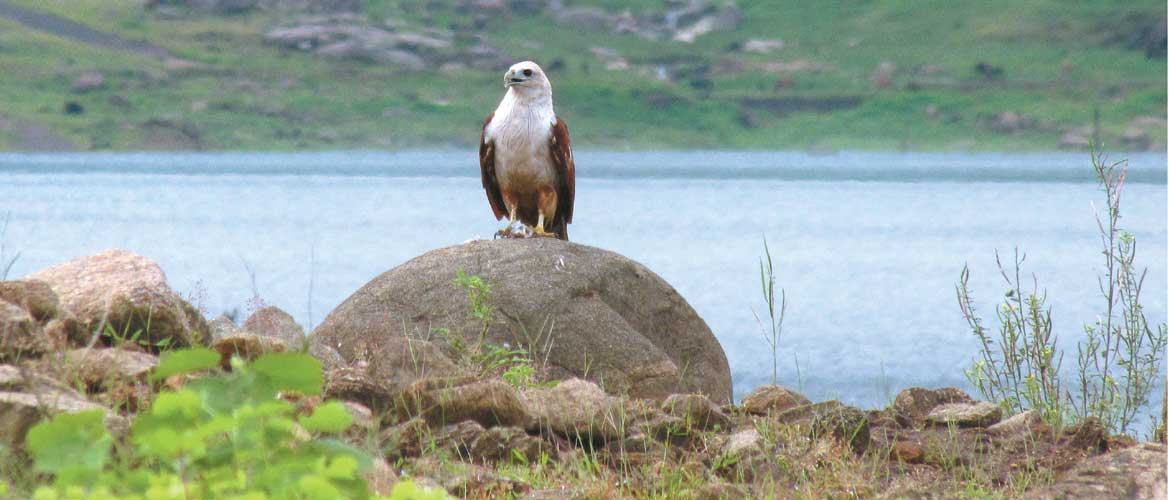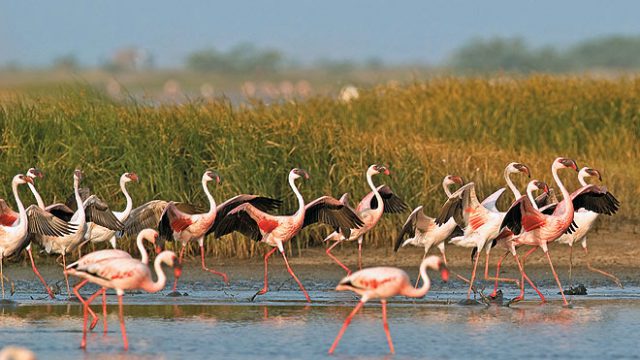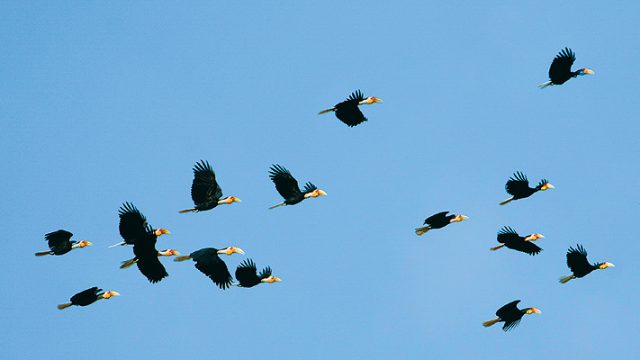Mountains rise around the shimmering lake at the Chimmony Wildlife Sanctuary. The hill slopes are
The signs of elephants are unmistakable, even though animals are not easy to spot at Chimmony. The dense forest cover helps mouse deer and bears alike to hide from inquisitive human eyes. The ground is a swirl of dry leaves, which crackle under one’s feet, making it difficult to go unnoticed.
As a result of the government restrictions at Chimmony there is no insistent, intrusive wildlife tourism, no chasing of tigers with walkie-talkies or groups of excitable party-goers scaring off birds. Instead, there are the affable members of Chimmony’s Eco-Development Committee, working with the tribal community on forest conservation, and the helpful officials of the Wild Kerala Tour Company, who are the only ones authorised to make camping trips into the forests. This makes it possible to experience memorable and rare moments, such as a sambar unwittingly crossing one’s path, flying squirrels peering from the treetops and Malabar grey hornbills throwing seeds up into the air to crack them open for a meal. There are also creepers whose stems yield almost two glasses of water and clusters of chocolate brown bracket fungus.

Be sure to visit the Naked Maiden of the Forest, a curiously named tree known for its constantly peeling bark. The ground nearby is marked by bears trying to scratch out roots. Lichen covers the stones here, notable because it marks how untouched this sanctuary is, as lichen only grows in pollution-free areas. Cinnamon leaves add a delicate fragrance to the air, while wild pepper adds a spicy note.
Biodiversity and Tribal Culture
The Chimmony forest area is incredibly biodiverse. The forest cover comprises tropical evergreen, semi-evergreen and moist deciduous trees, as well as shrubs, herbs, orchids and undergrowth. Some of the plant species here are endangered.
The flora provides shelter to 110 species of birds, including 22 migratory birds, 31 species of fish, 25 species of reptiles, 14 amphibian species and around 100 odd butterflies and moths. The 39 species of mammals include tiger, leopard, bear, langur, gaur, deer and wild boar. Being such a natural space, which is devoid of pollution and disturbances, Chimmony has also attracted butterfly migrations, where thousands of butterflies congregate in one spot.
The sanctuary is home to the Malaya tribe, comprising just a little over 200 people. This is the only tribe that lives within the boundaries of the reserve, in a peaceful and symbiotic relationship with the flora and fauna.

WHERE TO STAY AND EAT
The Eco-Development Committee is working on offering responsible, tribal-based eco-tourism. Tourism of this nature involves responsible travel, conservation, welfare as well as education. Visitors show up during the day for activities such as birding, bamboo rafting, jungle craft, animal tracking and nature walks. At night, visitors may stay at the Eco-lodges at Anaporu and Mankuzhy, or camp at Virakuthodu. The latter is best known for attracting elephants. Tariff for stay at Anaporu and Mankuzhyis
₹6,950 for three persons and includes all meals, stay and travel to and from Chimmony to the Eco-lodge. Cost of stay at Virakuthodu is
₹4,500 for two persons including meals. The ecolodges at Thottapura and Mulapura are currently closed. For bookings, contact the Wildlife Warden .
The Wild Kerala Tour Company (Cell: 09846162157) organises oneto three-day long tours and treks in the forests. They will arrange for camping equipment such as tents and sleeping bags. Travellers have the opportunity to bathe in the tributaries of the Periyar river, and holes are dug in the ground for calls of nature. Liquor is not allowed. They offer the Wild Serendipity (2D/1N) and Exploring Chimmony (3D/ 2N) tours.
The Wildlife Department offers stays at the Inspection Bungalowin Chimmony.

Peechi-Vazhani WLS
This 125-sq-km sanctuary lies between the twin reservoirs at Peechi and Vazhani. One of Kerala’s oldest wildlife reserves, it was set up in 1958, 26 years before Chimmony was declared a protected area. Thousands of birds are attracted to this sanctuary by the lakes, the Kurumali, Manalippuzha and Vadakkancheri rivers and the Paingottupadam, Pathrakkandam and Pothiyadukky vayals. The sanctuary officials organise a three-day trek from Chimmony to the Peechi Sanctuary.
When to go September to March Location Chimmony Wildlife Sanctuary lies 35 km from Thrissur. It is spread over 100 sq km on the western slopes of the Nelliyampathy hills, with a 10 sq km lake in the centre. Adjacent are the Peechi-Vazhani and Parambikulam sanctuaries. Air Nearest airport: Kochi Rail Nearest rail: Thrissur
|
THE INFORMATION |
|
Tourist Offices Tourist Facilitation Centre Kerala Tourism Park View Thiruvananthapuram Tel: 0471-2321132 Tollfree: 18004254747 w keralatourism.org w ktdc.com |
|
District Tourism Promotion Council (DTPC) Thiruvananthapuram Tel: 0471-2315397 |
|
KTDC Central Reservations, Mascot Square PMG Junction Thiruvananthapuram Tel: 2316736, 2725213 |
|
Tourist Information Office Kerala Tourism Travancore Palace Kasturba Gandhi Marg New Delhi Tel: 011-23382067 Sulthan Bathery/ Vythiri |
|
District Tourism Promotion Council (DTPC) Collectorate Office Civil Station Kalpetta North Tel: 04936-202134 Cell: 09446072134, 09387295184 W wayanadtourism.org STD Code 04936 |
|
THE INFORMATION |
|
Ponnani District Tourism Promotion Council (DTPC) Uphill, Malappuram Tel: 0483-2731504 W malappuramtourism.org/ STD Code 0494 Chimmony |
|
Wildlife Warden Chimmony Wildlife Sanctuary Chimmony Dam PO Tel: 0480-3209234 |
|
Wildlife Warden Peechi-Vazhani NP Tel: 0487-2699017, Cell: 0947979103 W forest.kerala.gov.in STD Code 0487 Alumkadavu |
|
District Tourism Promotion Council (DTPC) Near KSRTC Bus Stand, Kollam Tel: 0474-2745625, 2750170 W dtpckollam.com/ STD Code 0476 Pathanamthitta |
|
District Tourism Promotion Council (DTPC) Collectorate, Pathanamthitta Tel: 0468-2311343 W dtpcpathanamthitta.com |
|
Tourist Information Office Govt of Kerala Pathanamthitta Tel: 0468-2326409 STD Code 0468 |
Birding
Chimmony Wildlife Sanctuary
Kerala





